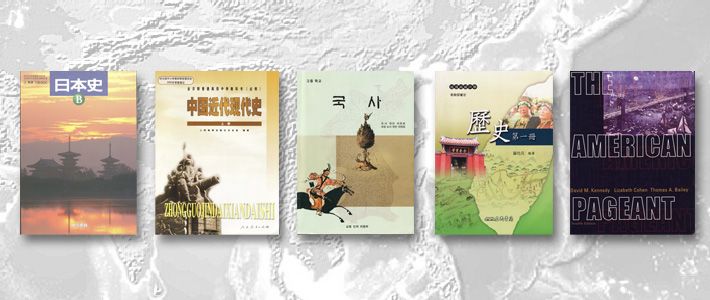
Japan’s Textbook Screening and History Textbook Controversies
Divided Memories: History Textbooks and the Wars in Asia
Politics Society- English
- 日本語
- 简体字
- 繁體字
- Français
- Español
- العربية
- Русский
Japanese history textbooks and their treatment of the wartime era has become an almost constant subject of international dispute in the last three decades. For critics, both inside and outside Japan, the content of those textbooks is evidence of a failure to take responsibility for the outbreak of the Asia-Pacific War or to acknowledge the suffering the Japanese military imposed on conquered Asian nations and the crimes committed in combat with the Allies. The decision of the Japanese education authorities to approve certain textbooks for use, or to reshape the content and language of the books, is presented as evidence of a nationalist tilt in Japan. Most importantly, Japanese textbooks were seen to fail to properly educate new generations of Japanese about their past.
Those views are not without some substance. Japanese history textbooks do not provide students with a detailed accounting of Japanese colonial rule, particularly in Korea. They have avoided or downplayed some of the more controversial aspects of the wartime period, such as the coercive recruitment of women for sexual services by the Japanese Imperial Army, the so-called comfort women. And at times, under pressure from conservative revisionists and their political supporters, the textbook screening process of the Ministry of Education has attempted to soften language describing Japan’s aggression.
The Divided Memories and Reconciliation project of the Walter H. Shorenstein Asia Pacific Research Center (APARC) at Stanford University, however, belies the essence of this widely held view of the particularly egregious nature of Japanese history textbooks. The project, directed by Professor Gi-Wook Shin and myself, was a multiyear study to better understand how historical memory about the wartime period is being shaped. It began with history textbooks and moved on to look at the role of popular culture—in particular film—and of elite opinion in shaping the view of the wartime past. Significantly, the Stanford project adopted a comparative approach, looking at Japan in comparison with other major Pacific war participants, principally China, South Korea, and, not least, the United States.
Methodological Approach for the Project
The study of history textbooks deliberately avoids the trap of focusing on the most controversial, and least used, textbooks. The project compared the treatment of the wartime and immediate postwar periods (1931–51) in Asia in the most widely circulated high school national history or world history textbooks recently or currently in use in China, Taiwan, South Korea, Japan, and the United States, along with textbooks used for college-preparatory classes (with the aim of focusing on the formation of elite opinion). Translations of those textbooks were prepared and the research team presented comparative excerpts of the treatment of eight key historical issues, such as the Marco Polo Bridge incident and the atomic bombing of Japan. This allowed scholars, experts, the media and others, for the first time, to actually compare how historical memory is shaped in those school systems. It broadened the context for understanding the role of textbooks beyond those used only in Japan.(*1)
The textbooks were selected based on two criteria. First, the project sought to identify the most widely used national and world history textbooks in senior high schools. Where it existed, that selection relied on data provided by the national government agencies (Japan, South Korea, and Taiwan) on textbook usage. In the case of the People’s Republic of China, until recently only one textbook publisher was authorized. In the case of the United States, where no national data exists, the project selected textbooks based on publishers’ data and on California usage, with the advice of the Stanford program on International and Cross-Cultural Education (SPICE), which creates and distributes supplementary teaching materials to high schools across the country. In the case of Japan, the project selected the textbooks that are overwhelmingly used in Japanese high schools, published by Yamakawa Shuppansha. The decision was consciously made not to compare the textbooks published by the Japanese Society for History Textbook Reform that, while they receive lots of attention outside of Japan, are used in a tiny fraction—well less than 1%—of Japanese school districts.
Second, the project also selected, where available, textbooks that were provided for college-preparatory level courses, equivalent in the United States to textbooks for Advanced Placement–level courses. The intent in this second case was to capture the educational material more likely to have been used by elites in all the school systems. In the US case, two American history and two World history textbooks were selected—one set is used in general education classes while the second set (World Civilizations: The Global Experience and The American Pageant: A History of the Republic) are the most commonly adopted textbooks for AP courses. In the Japanese case, the history textbook published by Tokyo Shoseki is considered equivalent to AP-level usage in the United States, as is the South Korean history textbook published by Keumsung publishers.
In the course of the project, the researchers became aware of significant revisions of the textbooks of China and Taiwan, which were being introduced in both systems, though not yet in all classrooms. In those two cases, the newly revised textbooks offered very different accounts of this wartime period. The “old” and “new” textbooks in those two systems were both translated and excerpted in this study, offering an interesting internal comparison as well.
Heavy on Facts, Light on Patriotism
What the research uncovered was quite different from the common perception found in media, not only in Asia but also in the United States. Far from being nationalistic, Japanese textbooks seem the least likely to stir patriotic passions. They do not celebrate war, they do not stress the importance of the military, and they tell no tales of battlefield heroism. Instead they offer a rather dry chronology of events without much interpretive narrative.
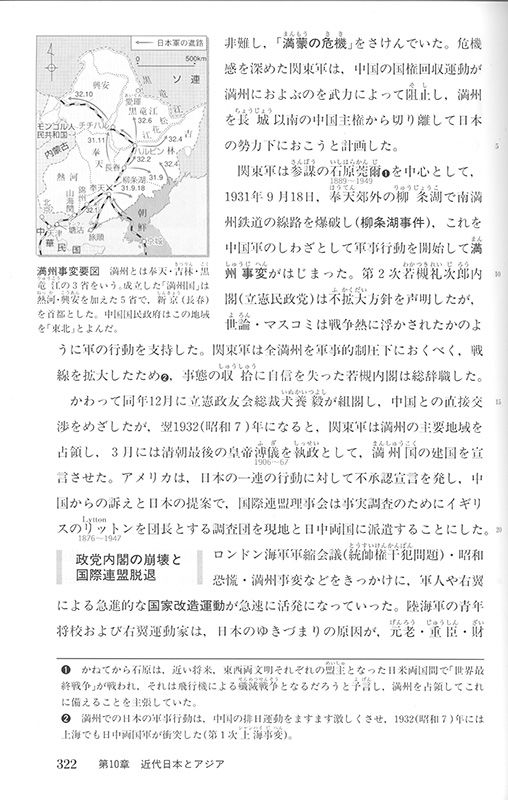 Passage from a Japanese history textbook on the 1931 “Manchurian Incident.”
Passage from a Japanese history textbook on the 1931 “Manchurian Incident.”
Japanese textbooks are deliberately written in this somewhat subdued manner, partly to avoid overt interpretation and because they are aimed at preparing students for university entrance examinations. Nonetheless, Japanese textbooks do offer a clear, if somewhat implicit, message: the wars in Asia were a product of Japan’s imperial expansion and the decision to go to war with the United States was a disastrous mistake that inflicted a terrible cost on the nation and its civilian population. Indeed, that basic tale is what prompted revisionist critics to author their own textbooks to correct what was seen as a “masochistic” view of modern Japan.
Contrary to popular belief, Japanese textbooks by no means avoid some of the most controversial wartime moments. The widely used textbooks contain accounts, though not detailed ones, of the massacre of Chinese civilians in Nanjing in 1937 by Japanese forces.(*2) Some, but not all, of the textbooks also describe the forced mobilization of labor in the areas occupied by Japan, including mention of the recruitment of “comfort women” to serve in wartime brothels.(*3) One clear lacuna is the almost complete absence of accounts of Japanese colonial rule in Korea.
History as Our Story
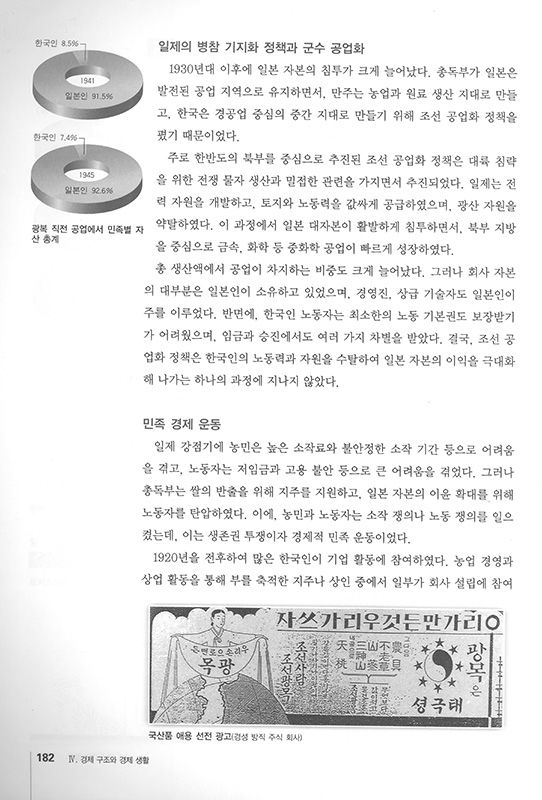 Passage from a South Korean history textbook on the economy under Japanese colonial rule.
Passage from a South Korean history textbook on the economy under Japanese colonial rule.
From their earliest days, history textbooks “have been fashioned to nurture a sense of national identity,” points out Stanford historian Peter Duus, one of the collaborators in our project.(*4) In this regard, Duus argues, the Japanese textbooks are perhaps the least overt in their mission to present a patriotic narrative about the story of the nation. In contrast, national curriculum guides in most other East Asian countries assert the promotion of national pride and national identity as the primary function of history education. The “war stories” told in their textbooks are clearly intended to do just that, Duus notes.
The desire to nurture a sense of national pride sometimes produces curious forms of myopia about the wartime period, most notably in the South Korean textbooks. The narrative of the wartime period offered to South Korean students is focused almost entirely on the oppressive experience of Koreans under Japanese colonial rule and on tales of Korean resistance to their overlords. The larger wartime context for Japan’s increasingly desperate and forced mobilization of Koreans for the war effort—namely the quagmire of the war in China and the mounting retaliatory assault of the Americans after 1942—is not provided. South Korean textbooks barely mention the outbreak of war in China in 1937 or the attack on Pearl Harbor, and in the case of the main textbook published by the government there is no mention at all of the atomic bombing of Hiroshima and Nagasaki.
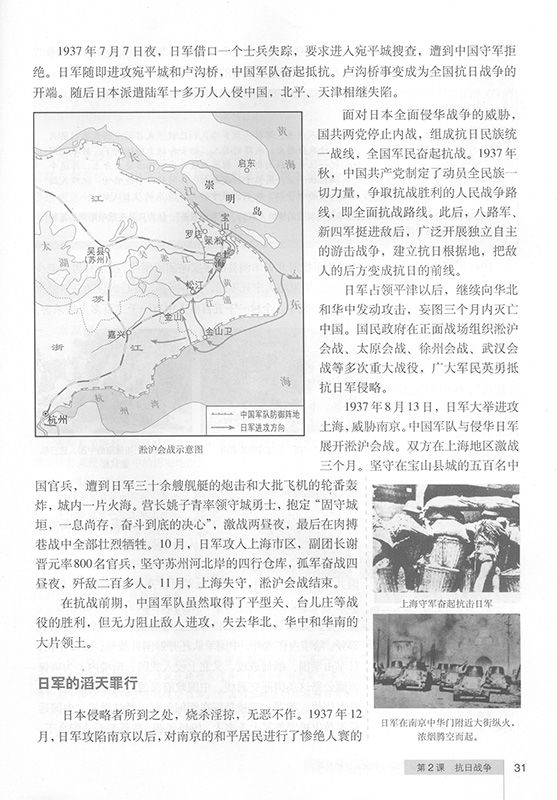 Passage from a Chinese history textbook on the beginning of the Sino-Japanese War in 1937.
Passage from a Chinese history textbook on the beginning of the Sino-Japanese War in 1937.
Chinese textbooks are most obviously imbued with a passionately patriotic and ideologically shaped narrative of the war. In the textbooks used up until the last decade, the war story is one of heroic military operations mounted by the Chinese, and for the most part by the Communists, against Japan. Little or no mention is made of the fighting in the Pacific or the role of the Allied powers. The role of the atomic attacks in ending the war is mentioned in only a single line. Mao Zedong’s call for an all-out attack on Japanese forces and the Soviet declaration of war in August 1945 are seen as the decisive factors. The victory in the anti-Japanese war represents, in this account, the end to a century of humiliation at the hands of foreign imperialists who rode roughshod over China’s rights and interests, and the return of China to its historical position as a major world power.
The Chinese textbooks, published by the People's Education Press, underwent a significant revision in 2002. The revised textbooks were slowly introduced around the country and offer a distinctly more nationalistic account of the wartime period. The previous edition focused on the civil war struggle between the Communist Party and the Nationalists, supporting Communist claims to have borne the brunt of the resistance to the Japanese invasion. The new version downplays the civil war in favor of a narrative of national unity against Japan. The Nanjing massacre had previously been downplayed—it was inconveniently a battle in which the Nationalists played the main role. Now Nanjing occupies extensive space in the textbooks, complete with graphic descriptions of Japanese atrocities.
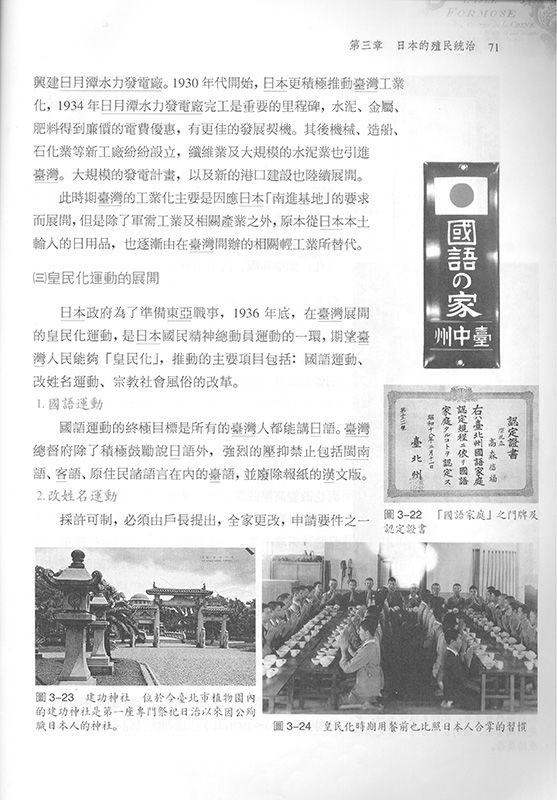 Passage from a Taiwanese history textbook on the Japanization movement under Japanese colonial rule.
Passage from a Taiwanese history textbook on the Japanization movement under Japanese colonial rule.
The long used Chinese textbook hewed closely to classic Marxist historiography, presenting the war as an outgrowth of the crisis of capitalism and as a struggle against fascism, led by the Soviet Union and its Communist allies in China. The revised textbook largely drops that Cold War rendition in favor of tale of national resistance against a foreign invader. In its narrative about the events leading to the Japanese invasion of China, for example, the 2002 Chinese textbook offers an extensive quote from the so-called Tanaka Memorial to demonstrate the origins of Japanese ambitions in Asia from the 1920s. That there were aggressive Japanese ambitions in Asia during this period is undoubted, but modern historiography in the West and in Japan considers the “Tanaka Memorial” a spurious document.
Red, White, and Blue Textbooks
Perhaps surprisingly to some, the American textbooks offer a similarly triumphant narrative of the war. The American Pageant, one of the most widely used textbooks in the United States, portrays the war as a critical turning point in the American maturation as an international power. Before the war the American people retreated from the outside world into a “head-in-the-sand” isolationism. The attack on Pearl Harbor brought the realization that isolation was no longer possible in a world of international anarchy. The unity of the American people forged by the attack, and equally important, the economic strength of the United States, brought victory in a global struggle against fascism, dictatorship, and militarism.
The language of the American account is unambiguous in portraying Japan as a rapacious aggressor and the United States as a largely innocent victim of unprovoked Japanese perfidy. The world history textbooks do offer more context for the start of the Pacific conflict, including the war in China and the rising tensions between Japan and the U.S. in the months leading up to the attack on Pearl Harbor. But the primary American history textbooks tend to ignore the war in Asia and present the conflict as having begun with Pearl Harbor and ending with the atomic bombing. American textbooks are much more willing, however, to present students with arguments for and against the decision to drop the atomic bombs, a debate that is absent from all the Asian textbooks.(*5)
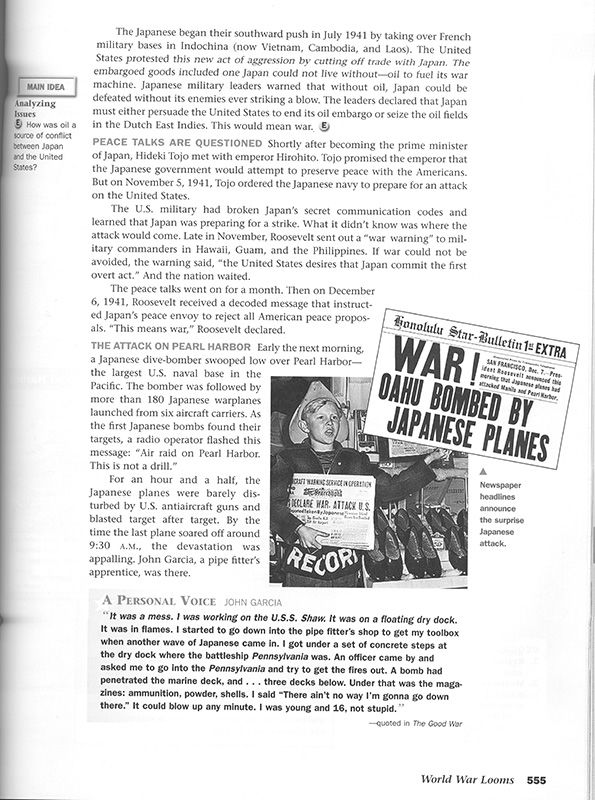 Passage from an American history textbook on the Pearl Harbor attack.
Passage from an American history textbook on the Pearl Harbor attack.
In an odd echo of the approach of the Chinese textbooks, the American account emphasizes that the victory made the United States the most powerful country in the world. The wartime triumph sets the stage, in this “war story,” for the postwar struggle against the Soviet bloc. Having learned the dangers of isolationism and appeasement, Americans emerged prepared to use their new global power status in a new struggle against the Communist threat.
The language of American textbooks is less blatantly nationalistic than the Chinese but it supports the country’s Cold War policies in much the same way Chinese textbooks support the triumph of the Communist Party. The war story in The American Pageant narrative is consistent with both the liberal internationalism and the conservative interventionism that governed American foreign policy from Truman and Acheson to Nixon and Kissinger. And like much in American popular culture, it celebrates World War II as a “good war.”
Pacifism Over Patriotism
The patriotic passions of the Chinese, Korean, and American accounts of the war provide a striking contrast to what Duus, a preeminent historian of modern Japan, describes as the “muted, neutral, and almost bland” tone of Japanese textbooks. This may surprise those whose view of Japanese textbooks is derived from accounts that conflate the content of the rarely used revisionist textbook with the textbooks that are actually on the desks of almost all Japanese high school students.
As Duus points out in our book, the primary reason that it is difficult to fashion the same kind of triumphalist narrative in Japan is simple—“Japan lost the war.”(*6) Almost as important is the lack, as demonstrated by the varying contents of Japanese textbooks, of a postwar consensus on how to interpret the war in Japan. The battle to shape the memory of the war is an ongoing one in Japan—in contrast to China, Korea, and the United States, where the grounds of contention about the past are much narrower. In Japan, there are still vigorous attempts to refute the view, held by a majority of Japanese, that the nation waged a war of aggression in Asia and the Pacific. Still, the dominant narrative in Japan is not of a war of liberation fought against Western imperialism but of a disastrous militarist adventure that should never be repeated.
The low-key treatment of the war in Japanese textbooks reflects the enduring legacy of that post-war pacifism. “While the war may have ended China’s century of humiliation and America’s isolationism,” Duus writes, “it also ended the Japanese illusion that national pride can be based only on military power.”
Reconciling Different Historical Views
The divergent nature of the accounts of the wartime period reflected in high school history textbooks helps us understand why it is so difficult to reach a common understanding of wartime history among the main combatants. That has frustrated the efforts of bilateral commissions formed by China and Japan and by South Korea and Japan to emulate the success of Germany and France in creating common textbooks. But the commissions do have some value in narrowing issues of contention and creating awareness of the parallel historical perceptions of others.
A barrier to reconciliation lies, in the view of the scholars of Shorenstein APARC, in the existence of conflicting historical memories of the war. But the path to reconciliation also lies through recognizing the divided nature of historical memory. “Understanding how each nation has created its own memory and identity is an important first step,” Professor Shin argues.(*7) By putting Japan in a comparative context, the Divided Memories project hopes to further the mutual understanding that can form the basis for enduring reconciliation.
(*1) ^ The results of this study, including the comparative excerpts and the commentaries of historians and textbook writers from China, Japan, Taiwan, South Korea and the United States were presented in Gi-Wook Shin and Daniel C. Sneider, eds., History Textbooks and the Wars in Asia: Divided Memories (New York: Routledge, 2011). A subsequent volume on the role of film in shaping wartime historical memory will be published by the University of Hawaii Press, and a third book on elite opinion, is being co-authored by Shin and Sneider.
(*2) ^ Shin and Sneider, pp. 27–30.
(*3) ^ Shin and Sneider, pp. 65–67.
(*4) ^ Peter Duus, “War Stories,” in Shin and Sneider, p. 101.
(*5) ^ Shin and Sneider, pp. 55–64.
(*6) ^ Duus, in Shin and Sneider, p. 113.
(*7) ^ Gi-Wook Shin, “History Textbooks, Divided memories, and Reconciliation,” in Shin and Sneider, p. 14.
patriotism History textbooks Daniel Sneider Gi-Wook Shin Asia-Pacific War Peter Duus national curriculum Tanaka Memorial Pearl Harbor isolationism militarism reconciliation APARC Divided Memories project